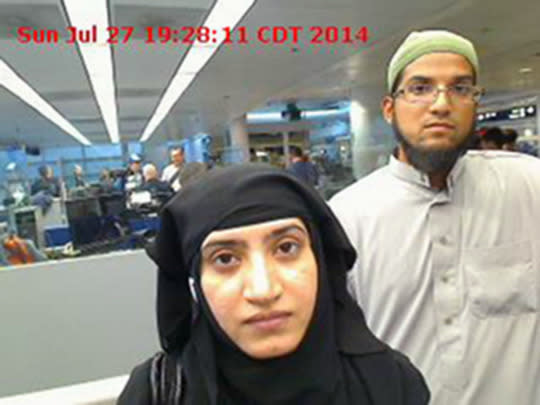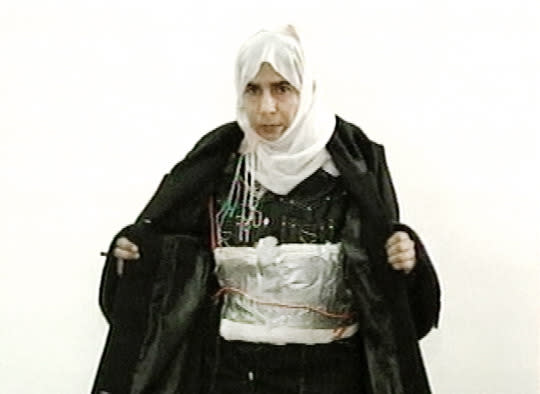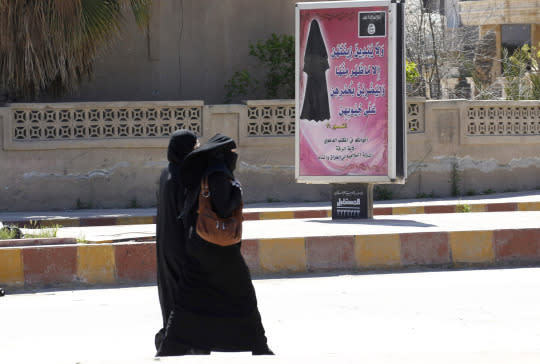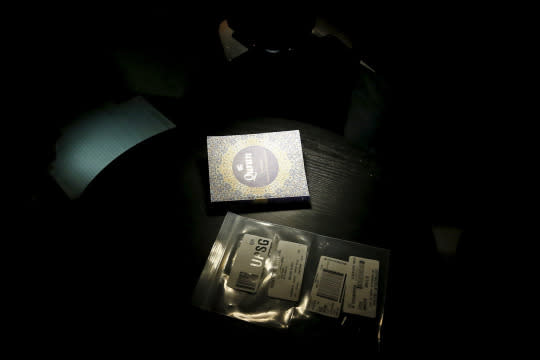ISIS thinks female jihadis should stay in the kitchen. Tashfeen Malik disagreed.

Tashfeen Malik, left, and Syed Rizwan Farook, as they passed through O’Hare International Airport in Chicago. (Photo: U.S. Customs and Border Protection/AP)
Tashfeen Malik reportedly donned tactical gear and a black mask alongside her husband last week when they attacked the Inland Regional Center in San Bernardino, Calif., where he worked. Both died in a protracted firefight with police a few hours later and are at the center of an investigation into the worst terrorist attack on U.S. soil since Sept. 11, 2001.
Malik, a 29-year-old Pakistani citizen with an infant, pledged loyalty to ISIS on Facebook before the deadly attack. But her actions do not necessarily reflect the ideals and rules ISIS has laid out for women and their role in the caliphate.
ISIS has so far said publicly that Malik and her husband, Syed Rizwan Farook, were “supporters of the caliphate” — refraining from calling them “soldiers,” as they have described followers in the past.
The group’s propaganda targeting Western women often features burka-clad girls toting AK-47s. ISIS’s message stresses the “empowerment” of women, according to Mia Bloom, a terror expert and professor at Georgia State University. It has been more successful in recruiting U.S. women than any other terror group, notes Karen Greenberg, the director of the Center on National Security at Fordham University’s School of Law. The group claims that feminism has failed women and that in the caliphate, they will be able to be their true, nurturing selves.
In practice, that means ISIS would rather women perform support roles for their fighter husbands and sons than engage in any combat. Last summer, an ISIS affiliate released detailed rules for women’s participation in fighting. The so-called Zura treatise, translated by terror expert Charlie Winter, encourages women to “support” men with their domestic abilities, suggesting “nursing, sewing … cooking, washing and other things.”
The document does detail a few circumstances in which it’s acceptable for women to participate actively as fighters. A woman is allowed to detonate a suicide bomb if she is attacked in her own home or if she is in a public place that is being attacked by “unbelievers.” In these situations, the treatise notes, she can detonate the belt “without the permission of others.”
Women may also act as snipers if they have permission. In special circumstances, they may even engage in martyrdom operations, such as the one Malik carried out. “But,” warn the rules, “only if the [leader] has permitted it and it is for the public good.”
“Mixing with the army or the brigade is not permissible because it leads to corruption,” the treatise says. This reluctance to let women fight sets ISIS apart from some other terror groups, which have held special camps to train women in combat.
“They project one image to attract women to the caliphate — and then, [the women] very quickly learn, your reality is not going to be holding the weapon,” Bloom says. “You may get a husband who doesn’t even let you leave the house.”

Iraqi Sajida al-Rishawi showing her suicide belt as she confesses on Jordanian state-run television in 2005 to her failed bid to set off the belt inside one of the three Amman hotels targeted by al-Qaida. (Photo: Jordanian TV via AP)
Some experts believe ISIS rules for women could have accommodated Malik’s actions. Rita Katz runs SITE Intelligence Group, a private intelligence firm that tracks global terrorist networks. She said the group hasn’t yet called the San Bernardino pair “soldiers” because it appears the couple were not in direct contact with ISIS before the attack.
“ISIS has used females for suicide operations in the past,” Katz says. “Being used for a suicide operation is not the same as being part of real combat.”
Katz pointed to the example of Sajida al-Rishawi, who was executed in Jordan earlier this year for her role in an attack that killed 60 people in that country, despite the fact that her suicide bomb did not detonate. ISIS burned a Jordanian pilot to death while demanding her release.

A billboard carries a verse from the Quran urging women to wear a hijab in the ISIS-controlled Syrian province of Raqqa. (Photo: Reuters)
The strict rules for women inside the caliphate are also different from what ISIS encourages women to do in their home countries, Katz said. ISIS videos that call for lone wolf attacks in the West are addressed to Muslims in general instead of “brothers,” a semantic distinction that clearly includes women.
“They would like other women in the West to be inspired by this act,” Katz said of Malik.
Authorities are still piecing together the ideology of Malik and Farook, though they believe the pair had been radicalized for quite some time and that Malik, at least, felt loyalty to ISIS. The Los Angeles Times reported that Malik had enrolled in an 18-month course at a women’s madrasa called the Al-Huda Institute in Multan, Pakistan, after she completed a pharmacology degree. She left before finishing the course to marry Farook, whom she met online.
Al-Huda is an incredibly popular religious school for women in Pakistan, and it is criticized for preaching a narrow and conservative version of Islam that forbids listening to music, speaking to men who aren’t relatives, and being uncovered in public. But despite its sometimes anti-Western, fundamentalist rhetoric, Al-Huda has never been linked to violence.
Its vision of women as helpmeets who should encourage the men in their lives to become more religious is in line with ISIS’s gender ideology, however. The school’s charismatic founder, Farhat Hashmi, teaches that women must veil themselves in order to maintain their husband’s interest and keep their families intact, according to the book Transforming Faith by Sadaf Ahmad. Hashmi also lectures wives to make themselves sexually available to their husbands at all times in order to prevent infidelity — another value ISIS shares.
A spokeswoman for Al-Huda told the New York Times that the group had nothing to do with Malik’s actions.

A copy of the Quran and a plastic delivery envelope are shown inside the home of suspects Syed Rizwan Farook and Tashfeen Malik in Redlands, Calif. (Photo: Mario Anzuoni/Reuters)


